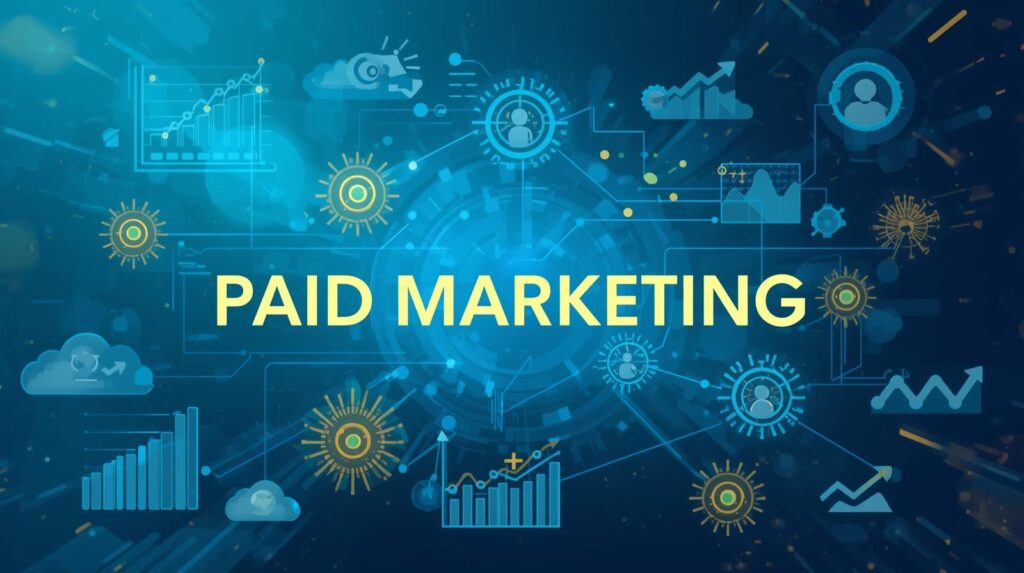In today’s fast-paced, highly competitive digital world, businesses must think outside the box to stay ahead of the curve. Traditional marketing strategies, like print ads, TV commercials, or billboards, are no longer the only ways to reach customers. With the rise of the internet and social media, businesses now have a wide array of tools at their disposal, and one of the most powerful tools is paid marketing.
Paid marketing allows businesses to quickly reach their target audience, generate leads, and drive sales. Unlike organic methods that can take months or even years to show results, paid marketing provides instant visibility and measurable results. Whether it’s through search engine ads, social media campaigns, or display ads, paid marketing is essential for companies that want to grow their brand, build an online presence, and stay competitive in the digital marketplace.
In this article, we’ll explore what paid marketing is, the different types of paid marketing strategies, how to get started with paid campaigns, and why it’s crucial for businesses of all sizes to integrate paid marketing into their overall marketing strategy.
What is Paid Marketing?
Paid marketing refers to the practice of paying for ad placements on various platforms like Google, Facebook, Instagram, LinkedIn, and other digital networks. This can include pay-per-click (PPC) ads, display ads, social media ads, and even influencer marketing, where brands pay influencers to promote their products or services.
The core idea behind paid marketing is simple: businesses pay to put their message in front of their target audience at the right time and in the right place. Unlike organic methods, where you have to wait for search engines or social algorithms to notice your content, paid marketing ensures that your brand is immediately visible.
Paid marketing is not only limited to large corporations with big budgets. Small and medium-sized businesses (SMBs) can also benefit significantly from paid marketing strategies, making it an accessible and effective tool for businesses of all sizes.
Types of Paid Marketing
There are several forms of paid marketing, each designed to serve different business goals. Let’s break down some of the most popular forms of paid marketing that businesses use today:
1. Pay-Per-Click (PPC) Advertising
PPC advertising is one of the most common forms of paid marketing. It works by allowing businesses to bid on specific keywords that are relevant to their products or services. When someone searches for those keywords, your ad appears at the top of the search results. You only pay when someone clicks on your ad (hence the name “pay-per-click”).
Google Ads is the most widely used platform for PPC advertising. Other platforms, like Bing Ads and Yahoo Gemini, offer similar services. PPC ads can appear in search engine results, display networks, and even YouTube.
PPC is highly effective because it targets users who are actively searching for the products or services you offer. This increases the likelihood that the user will convert into a lead or customer.
2. Social Media Advertising
With billions of active users on social media platforms like Facebook, Instagram, Twitter, LinkedIn, and TikTok, social media advertising has become a major avenue for businesses to reach their target audience. Social media platforms allow businesses to run paid ads targeting specific demographics, including age, gender, location, interests, and more.
Social media ads come in various formats, including image ads, video ads, carousel ads, and sponsored posts. Social media advertising is incredibly effective because of its ability to reach a highly targeted audience in a more personal and engaging way. Users tend to spend significant time on social platforms, making it the perfect place for brands to connect with potential customers.
3. Display Advertising
Display ads are banner, sidebar, or pop-up ads that appear on websites, apps, and other digital platforms. These ads can include images, videos, or text and are usually shown to users based on their interests, behaviors, or browsing history.
Google Display Network (GDN) is one of the most popular platforms for display advertising. Through GDN, you can place your ads on millions of websites, reaching your target audience as they browse the internet. Display ads are great for brand awareness, remarketing, and engaging users who may not have interacted with your brand yet.
4. Influencer Marketing
Influencer marketing has gained significant traction in recent years. By partnering with influencers—individuals who have a large following on social media or other platforms—to promote your products or services. Influencers can create content that showcases your product, providing an authentic and relatable endorsement.
Influencer marketing works because it leverages the trust that influencers have built with their followers. Consumers are more likely to trust an influencer’s recommendation than a traditional ad. Influencer marketing can be highly effective for brands looking to build credibility and expand their reach.
5. Affiliate Marketing
Affiliate marketing is a performance-based marketing strategy in which businesses pay affiliates (individuals or companies) a commission for driving sales or leads through their referral links. Affiliates promote products or services through blogs, websites, social media, or email marketing.
Affiliate marketing is beneficial for businesses because it allows them to expand their reach without upfront costs. You only pay for actual sales or conversions, making it a low-risk strategy.
Benefits of Paid Marketing
1. Immediate Visibility and Results
One of the biggest advantages of paid marketing is the immediacy it offers. While organic methods like SEO and content marketing take time to produce results, paid ads provide instant visibility. As soon as your campaign goes live, your ads start appearing in front of your target audience, driving immediate traffic to your website.
2. Highly Targeted Audience Reach
Paid marketing allows businesses to target specific demographics based on factors like age, gender, location, interests, online behavior, and more. This level of precision ensures that your message reaches the right audience at the right time.
For example, if you’re a business selling fitness products, you can target individuals who have recently searched for home workout gear or follow fitness-related accounts on social media. This level of targeting makes paid marketing much more effective than traditional advertising, which is often more generalized.
3. Scalability and Flexibility
Paid marketing is highly scalable. As your business grows, you can easily increase your ad spend, expand your targeting options, and test new strategies. Whether you’re working with a small budget or a large one, paid marketing can be adjusted to fit your needs.
Additionally, paid ads are flexible in nature. If a particular campaign isn’t performing well, you can quickly adjust your ad copy, targeting, or budget. Regular monitoring and adjustments are key to ensuring that your campaigns stay on track and deliver the best results.
4. Measurable Results
With paid marketing, the results are measurable. Platforms like Google Ads and Facebook Ads provide detailed analytics that shows you exactly how your campaigns are performing. Metrics such as click-through rates (CTR), conversion rates, and return on investment (ROI) allow you to assess the effectiveness of your campaigns.
By tracking these metrics, you can make data-driven decisions and continuously optimize your campaigns for better results.
Best Practices for Paid Marketing
1. Set Clear Goals
Before launching any paid marketing campaign, it’s essential to set clear goals. Are you looking to increase brand awareness, generate leads, or drive sales? Knowing your goals will help you choose the right platform, ad format, and targeting options to achieve the best results.
2. Monitor and Optimize Your Campaigns
Paid marketing campaigns should be continuously monitored and optimized. Track the performance of your ads and make adjustments as needed. A/B testing, where you test different ad variations, can help you identify what works best for your audience.
3. Create High-Quality Content
Whether you’re running search engine ads, social media campaigns, or display ads, the quality of your content matters. Your ads should be visually appealing, your messaging should be clear, and your call to action should be compelling. High-quality content increases engagement and improves your chances of conversion.
4. Use Retargeting to Boost Conversions
Retargeting is a powerful paid marketing strategy that targets users who have interacted with your brand but didn’t convert. By showing your ads to these users again, you increase the likelihood of conversion, as they are already familiar with your brand.








Leave a Reply